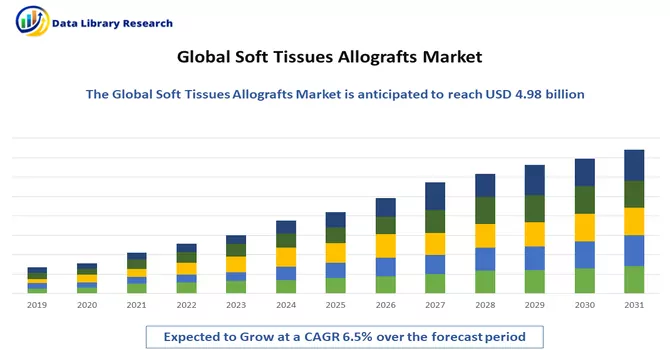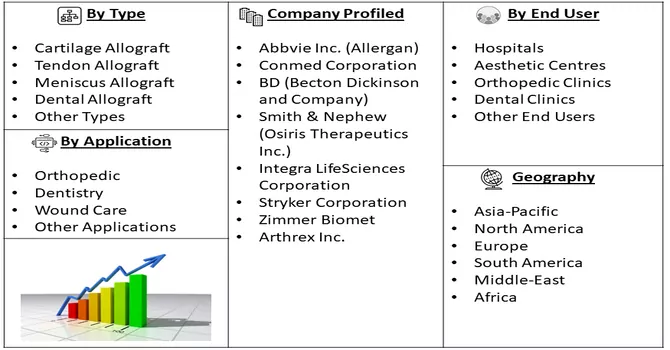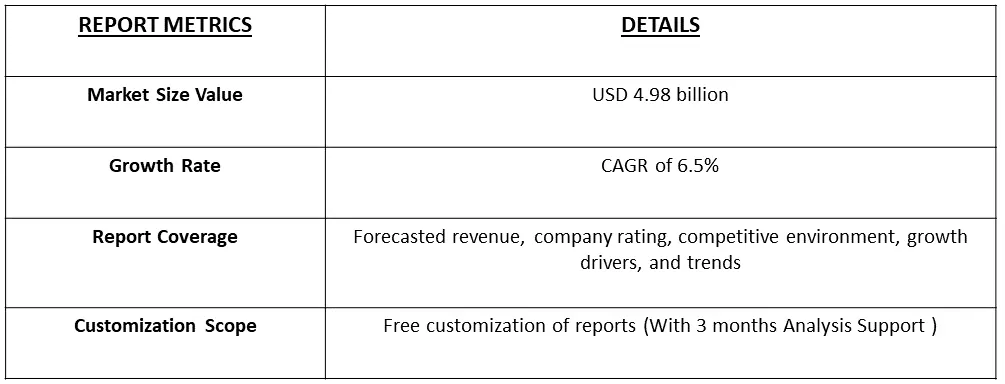The soft tissue allografts market which was USD 4.98 billion in 2022, is expected to register a CAGR of 6.5% over the forecast period, 2023-2030.

Get Complete Analysis Of The Report - Download Free Sample PDF
Soft tissue allografts refer to biological tissues that are harvested from a donor and transplanted to a recipient within the same species. These allografts, often derived from human donors, are utilized in medical procedures to repair, reconstruct, or augment damaged or deficient soft tissues. Soft tissue allografts can include various types of tissues, such as tendons, ligaments, cartilage, skin, and other connective tissues.
The continuous growth in healthcare expenditure globally supports investments in advanced medical technologies and procedures, including soft tissue allografts. Adequate financial resources contribute to the accessibility and adoption of these innovative treatment options. The increasing incidence of musculoskeletal disorders, such as ligament injuries, tendon ruptures, and osteoarthritis, propels the demand for soft tissue allografts. Allografts offer effective solutions for repairing and reconstructing damaged soft tissues, addressing the growing burden of orthopedic and sports-related injuries.
The Soft Tissue Allograft Market is marked by dynamic trends that shape the industry's landscape and influence its trajectory. Increasing interest in regenerative medicine principles has led to a surge in the use of soft tissue allografts, which possess regenerative properties. Regenerative medicine approaches focus on harnessing the body's natural healing mechanisms, aligning with the regenerative potential of allografts. Continuous advancements in tissue processing technologies enhance the quality, safety, and functionality of soft tissue allografts. Moreover, the improved processing techniques contribute to the preservation of biomechanical properties, making allografts more clinically effective.
Market Segmentation: The Soft Tissue Allografts Market is Segmented by Type (Cartilage Allograft, Tendon Allograft, Meniscus Allograft, Dental Allograft, and Other Types), Application (Orthopedic, Dentistry, Wound Care, and Other Applications), End User (Hospitals, Aesthetic Centres, Orthopedic Clinics, Dental Clinics, and Other End Users) and Geography (North America, Europe, Asia-Pacific, Middle East and Africa, and South America). The report offers the value (in USD million) for the above segments.

For Detailed Market Segmentation - Download Free Sample PDF
Market Drivers :
Growing Cases of Orthopedics and Dentistry Related with Aging
The escalating cases of orthopedic and dentistry issues associated with aging have prompted an increased utilization of tissue allografts in medical interventions. As the global population experiences a demographic shift towards aging, there is a parallel rise in conditions related to musculoskeletal health and dental concerns. This demographic trend has significant implications for the fields of orthopedics and dentistry, leading to a growing reliance on tissue allografts for effective treatment and restoration.
As per data released by the National Safety Council of the United States in 2021, approximately 3.2 million individuals sought treatment in emergency departments for injuries related to sports and recreational equipment in the country. The prevalent activities associated with these injuries included exercise, cycling, and basketball. In 2021, the injury rate per 100,000 population in the United States was 123.8 for exercise, 113.7 for bicycles and accessories, 78.6 for basketball, 74.2 for skateboards, scooters, and hoverboards, and 67.2 for football. This substantial incidence of sports-related injuries underscores a heightened demand for soft tissue allografts within the realm of athletics and other sports, significantly contributing to the overall growth of the market. Thus, such factors are expected to contribute to the growth of the studied market.
Increasing Demand for Soft Tissue Allografts in Athletics and Other Sports and Technological Advancement
The escalating demand for soft tissue allografts in athletics and other sports is a prominent trend driven by the imperative need for effective solutions in treating sports-related injuries. This surge in demand can be attributed to several factors, including the growing prevalence of sports injuries and the quest for advanced medical interventions to enhance recovery in athletes.
As an illustration, AlloSource introduced AlloMend Extra-Large (XL) Acellular Dermal Matrix (ADM) in October 2021, presenting a dermal graft with optimal handling characteristics that facilitate precise placement. Additionally, in January 2021, Direct Biologics LLC unveiled AmnioWrap, a placental-based sheet allograft designed for clinical use. AmnioWrap, featuring a distinctive tri-layer structure, is specifically intended for applications in both acute and chronic wounds. The increasing number of approvals and strategic partnerships within the industry is anticipated to drive market growth throughout the forecast period.
Thus, the increasing demand for soft tissue allografts in athletics and sports is closely intertwined with technological advancements. As technology continues to progress, soft tissue allografts evolve to offer improved biomechanical properties, regenerative capabilities, and personalized solutions. This symbiotic relationship between technological innovation and tissue allografts not only addresses the immediate needs of athletes but also holds promise for the future development of advanced and patient-centric interventions in sports medicine.
Market Restraints
High Cost of Treatment and Reimbursement Issue
The potential impediments to the growth of the soft tissue allografts market include the high cost of treatment and issues related to reimbursement. These factors have the capacity to slow down the market expansion and influence the accessibility of soft tissue allograft procedures for patients. The reimbursement issues, including limitations in coverage by healthcare payers, can create financial barriers for patients seeking soft tissue allograft procedures. Insufficient reimbursement may deter healthcare providers from offering these treatments, impacting patient access and overall market growth. Affordability issues can contribute to challenges in patient compliance, as individuals may opt for alternative, more cost-effective treatment options. This could lead to suboptimal patient outcomes and impact the overall growth trajectory of the soft tissue allografts market.
The soft tissue allografts market experienced a notable impact from the initial phases of the COVID-19 pandemic, primarily attributed to the widespread cancellations of soft tissue repair procedures. For instance, a study conducted in Poland, as reported in the International Journal of Environmental Research and Public Health in March 2021, highlighted a substantial decline in the number of dental procedures, including dental repair procedures, during the early stages of the pandemic. Moreover, a study conducted in Scotland and documented in the Cureus Journal in September 2022 revealed a significant reduction in the total number of hernia repair surgeries in the country during the initial pandemic period. The decline was largely attributed to the decrease in elective operations, with the percentage of elective repair surgeries dropping significantly from 85.6% to 58.4%. However, as restrictions were lifted in the past two years, and soft tissue allograft procedures resumed globally, the market showcased a recovery. Anticipated to exhibit a stable growth rate during the forecast period, this resilience in the market suggests a rebound from the pandemic-induced disruptions, indicating a return to normalcy in the demand for soft tissue allografts.
Segmental Analysis
The Orthopedics Segment Is Anticipated To Experience Substantial Growth Throughout The Forecast Period
The segment’s growth primarily driven by the high prevalence of orthopedic soft tissue injuries. Soft tissue damage in areas such as the elbow, wrist, finger, thigh, and other body parts where tendons are present is a common occurrence, necessitating orthopedic surgical interventions. The frequent occurrence of orthopedic soft tissue ruptures in these areas contributes significantly to the demand for orthopedic procedures, fostering the growth of this segment. For example, data from the 2021 update of the American Joint Replacement Registry (AJRR) indicates that approximately 105,743 hip arthroplasty procedures for femoral neck fractures were conducted in the United States in 2020. The rising number of orthopedic procedures, particularly those addressing soft tissue injuries, is expected to be a key driver for the growth of the orthopedics segment.
Accidental injuries also play a substantial role in shaping the market landscape, affecting soft tissues in various parts of the body. Data published by the Government of the United Kingdom in May 2022 reveals that approximately 27,300 seriously injured casualties were reported in Great Britain in 2021. Additionally, according to the 2022 data from the Brake Organization, around 26,701 people in the United Kingdom, including both Britain and Northern Ireland, suffered serious injuries in 2021 due to accidents. The consequential impact of accidents on soft tissues is projected to contribute significantly to the growth of the orthopedics segment. The successful execution of surgeries utilizing orthopedic allografts by market players is expected to further drive demand in this segment. For instance, in December 2022, Umbra Applied Technologies Group, Inc. achieved successful surgeries using the Ossifix Orthopedics allograft bone pin system, showcasing the effectiveness of orthopedic allografts in clinical applications.
Thus, the orthopedics segment is poised for substantial growth during the forecast period, fueled by the prevalence of soft tissue injuries, the increasing number of orthopedic procedures, and successful surgical outcomes using orthopedic allografts.
Cartilage Allografts Segment is Expected to Witness Significant Growth Over the Forecast Period
Cartilage allografts involve the transplantation of cartilaginous tissue from a donor to a recipient, aiming to restore damaged or degenerated cartilage. These allografts can be derived from various sources, including articular cartilage, meniscus, or osteochondral tissues. Advanced processing techniques, such as cryopreservation and decellularization, enhance the viability and longevity of cartilage allografts. Research focuses on optimizing the integration of allografts into the host tissue and promoting long-term functional outcomes. Thus, cartilage allografts and soft tissue allografts represent pivotal advancements in regenerative medicine, offering versatile solutions for a spectrum of medical conditions. As research continues and technology evolves, these allografts are poised to play an increasingly significant role in promoting tissue healing, improving patient outcomes, and advancing the frontiers of musculoskeletal care.
Hospitals Segment is Expected Witness Significant Growth Over the Forecast Period
Hospitals play a pivotal role in the utilization and application of soft tissue allografts, serving as key hubs for surgical interventions and medical procedures. The incorporation of soft tissue allografts in hospital settings is particularly prominent in orthopedic and reconstructive surgeries. Hospitals are primary centers for orthopedic surgeries that involve soft tissue allografts. These procedures address a range of conditions, including ligament and tendon injuries, joint reconstruction, and musculoskeletal disorders. The orthopedic departments within hospitals often collaborate with tissue banks to source high-quality allografts for these surgeries. Post-surgical care and rehabilitation within hospital settings involve monitoring patients who have undergone soft tissue allograft procedures. Hospitals provide comprehensive care pathways to ensure optimal recovery and functionality after surgeries involving allografts.
Thus, the collaboration between hospitals and the use of soft tissue allografts is multifaceted, encompassing surgical applications, research initiatives, educational endeavors, and the overall enhancement of patient care in the field of orthopedics and reconstructive surgery.
North America Region is Expected to Witness Significant Growth Over the Forecast Period
North America is poised to command a significant market share, driven by various factors such as a high prevalence of sports injuries, continuous product launches and approvals, and the substantial presence of key market players in the region. The 2022 Annual Report from the Arizona Department of Health Services, State Trauma Advisory Board revealed that in 2021, Arizona, United States witnessed a substantial number of trauma cases, with falls, motor vehicle traffic (MVT)-occupant incidents, and other injury mechanisms topping the list. Specifically, falls accounted for 30,788 cases, MVT-occupant incidents for 12,247, and various other mechanisms such as struck by/against, motor vehicle non-traffic, cut/pierce, and firearms were reported. Additionally, pediatric traumatic injuries numbered 7,069 in 2022, with falls, MVT-occupant incidents, motor vehicle non-traffic, and struck by/against being the leading causes among children aged 0-17 years.
The region's market growth is further fueled by industry initiatives, including conferences aimed at raising awareness about available allograft products. For example, in January 2021, AlloSource's ProChondrix CR allograft was featured in a presentation by Dr. David Argo at the British Patellofemoral Society Meeting. Dr. Argo shared his experiences using AlloSource's allograft in knee osteochondral defect repairs in Ohio, contributing to increased demand among orthopedic physicians. Thus, the combination of prevalent sports injuries, ongoing product awareness initiatives, and the strategic presence of market players positions North America as a key driver of growth in the allograft market.

Get Complete Analysis Of The Report - Download Free Sample PDF
The soft tissue allografts market exhibits a moderate level of competitiveness, with the presence of numerous global players actively participating in the market landscape. The presence of numerous global players suggests a dynamic and multifaceted market environment. These players likely bring diverse product offerings, technological innovations, and strategic approaches to the soft tissue allografts sector. Such diversity among market participants can foster competition, encouraging ongoing advancements and improvements within the industry. In a moderately competitive market, companies may be driven to differentiate themselves through various means, including product quality, innovation, pricing strategies, and market reach. This competition can result in a more robust market where consumers have access to a range of choices, and companies are incentivized to continually enhance their offerings to meet evolving demands.
Some of the companies working in this domain are:
Recent Development
1) In August 2022, the inaugural meniscal transplant surgery, involving the implantation of donor cartilage into the knee, was successfully conducted by orthopedic surgeons at the University National Hospital in Scotland.
2) In July 2022, AlloSource expanded its AlloConnex line of tendons, ligaments, and fascia by introducing the quadricep tendon. Designed for cruciate ligament procedures, AlloSource's AlloConnex quadricep tendon is now part of their offerings, available with or without the bone block to accommodate various surgical techniques.
Q1. What was the Soft Tissues Allografts Market size in 2022?
As per Data Library Research the soft tissue allografts market which was USD 4.98 billion in 2022.
Q2. What is the Growth Rate of the Soft Tissues Allografts Market?
Soft Tissues Allografts Market is expected to register a CAGR of 6.5% over the forecast period.
Q3. What are the factors on which the Soft Tissues Allografts Market research is based on?
By Type, By Application, End-User and Geography are the factors on which the Soft Tissues Allografts Market research is based.
Q4. What are the Growth Drivers of the Soft Tissues Allografts Market?
Growing Cases of Orthopedics and Dentistry Related with Aging and Increasing Demand for Soft Tissue Allografts in Athletics and Other Sports and Technological Advancement are the Growth Drivers of the Soft Tissues Allografts Market.
Data Library Research are conducted by industry experts who offer insight on industry structure, market segmentations technology assessment and competitive landscape (CL), and penetration, as well as on emerging trends. Their analysis is based on primary interviews (~ 80%) and secondary research (~ 20%) as well as years of professional expertise in their respective industries. Adding to this, by analysing historical trends and current market positions, our analysts predict where the market will be headed for the next five years. Furthermore, the varying trends of segment & categories geographically presented are also studied and the estimated based on the primary & secondary research.
In this particular report from the supply side Data Library Research has conducted primary surveys (interviews) with the key level executives (VP, CEO’s, Marketing Director, Business Development Manager and SOFT) of the companies that active & prominent as well as the midsized organization
FIGURE 1: DLR RESEARH PROCESS

Extensive primary research was conducted to gain a deeper insight of the market and industry performance. The analysis is based on both primary and secondary research as well as years of professional expertise in the respective industries.
In addition to analysing current and historical trends, our analysts predict where the market is headed over the next five years.
It varies by segment for these categories geographically presented in the list of market tables. Speaking about this particular report we have conducted primary surveys (interviews) with the key level executives (VP, CEO’s, Marketing Director, Business Development Manager and many more) of the major players active in the market.
Secondary ResearchSecondary research was mainly used to collect and identify information useful for the extensive, technical, market-oriented, and Friend’s study of the Global Extra Neutral Alcohol. It was also used to obtain key information about major players, market classification and segmentation according to the industry trends, geographical markets, and developments related to the market and technology perspectives. For this study, analysts have gathered information from various credible sources, such as annual reports, sec filings, journals, white papers, SOFT presentations, and company web sites.
Market Size EstimationBoth, top-down and bottom-up approaches were used to estimate and validate the size of the Global market and to estimate the size of various other dependent submarkets in the overall Extra Neutral Alcohol. The key players in the market were identified through secondary research and their market contributions in the respective geographies were determined through primary and secondary research.
Forecast Model
